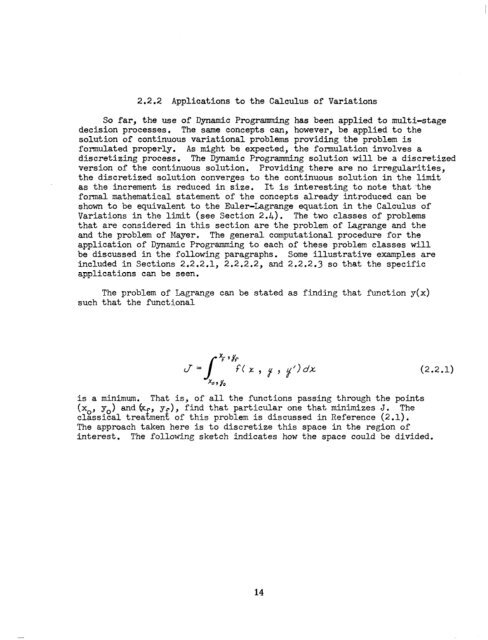guidance, flight mechanics and trajectory optimization
guidance, flight mechanics and trajectory optimization
guidance, flight mechanics and trajectory optimization
You also want an ePaper? Increase the reach of your titles
YUMPU automatically turns print PDFs into web optimized ePapers that Google loves.
2.2.2 Applications to the Calculus of Variations<br />
So far, the use of Dynamic Programmin g has been applied to multi-stage<br />
decision processes. The same concepts can, however, be applied to the<br />
solution of continuous variational problems providing the problem is<br />
formulated properly. As might be expected, the formulation involves a<br />
discretizing process. The Dynamic Programming solution will be a discretized<br />
version of the continuous solution. Providing there are no irregularities,<br />
the discretized solution converges to the continuous solution in the limit<br />
as the increment is reduced in size. It is interesting to note that 'the<br />
formal mathematical statement of the concepts already introduced can be<br />
shown to be equivalent to the Euler-Lagrange equation in the Calculus of<br />
Variations in the limit (see Section 2.4). The two classes of problems<br />
that are considered in this section are the problem of Lagrange <strong>and</strong> the<br />
<strong>and</strong> the problem of Mayer. The general computational procedure for the<br />
application of Dynamic Programming to each of these problem classes will<br />
be discussed in the following paragraphs. Some illustrative examples are<br />
included in Sections 2.2.2.1, 2.2.2.2, <strong>and</strong> 2.2.2.3 so that the specific<br />
applications can be seen.<br />
The problem of Lagrange can be stated as finding that function y(x)<br />
such that the functional<br />
is a minimum. That is, of all the functions passing through the points<br />
(x0, Y. ) <strong>and</strong> h , y ), find that particular one that minimizes J. The<br />
classical trea e men E of this problem is discussed in Reference (2.1).<br />
The approach taken here is to discretize this space in the region of<br />
interest. The following sketch indicates how the space could be divided.<br />
14<br />
(2.2.1)

















